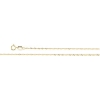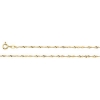Categories
- Jewelers Showcase Quotes
- Custom Made Rings
- Pendant Medals
- Custom Silver Pendants
- Factory Rings
- Chains & Bracelets
- Sterling Cross
- Baptism Jewelry
- Communion
- Gemstone Information
- Confirmation
- Gold & Silver Methodist Cross
- Greek
- Gold Orthodox Cross
- Silver Orthodox Cross
- Celtic
- Saint Brigid Cross
- Celtic Crosses
- 14K Gold Cross
- 4 Way Cruciform Cross Medals
- 14k White Gold Cross
- Customize-Shopwork
- New Products ...
- All Products ...
Information
Secure Payments
About Gold
About Gold.
You can rely on GemOptions Jewelry for fine quality solid karat gold.
Pure gold (fine gold) is softer than pure silver but harder than tin. Its beauty and luster are unmatched by any alloyed gold. The extreme malleability, ductility, and softness of pure gold make it practically useless for jewelry applications.
The addition of alloying elements (other metals) to gold are used to increase the toughness and hardness of the metal. While almost any metal can be alloyed (melted) with gold, only certain metals will not dramatically change the color or make the metal brittle. The addition of indium, for instance, turns gold purple and gives gold the workability of glass.
Over time, certain percentages of gold have become legally recognized "karats." Karat indicates the amount of gold as a percentage of the total, i.e. 24 karat is 100 percent gold. Thus 14 karat is 14/24's gold or 58-1/3 percent gold. Gold standards vary around the world. In the United States, 18, 14, and 10 karat gold are the only ratings allowed to be sold as karat gold.
In karat gold, there is a balance of metals in the non-gold percentage. These metals provide the various colors and hardness of karat gold. Typical alloying elements and their color effect are:
Copper Reddening
Silver Greening
Zinc Bleaching
Nickel Whitening
Palladium Whitening
Examples of the compositions of different colors are:
Yellow Gold, copper, silver, zinc
White Gold, copper, nickel, zinc
Red Gold, copper
Green Gold, silver
Adjusting the proportions of coloring agents provides the array of colors on the market. Additional metals enhance properties such as cast-ability, grain size, hardness, corrosion resistance, color, workability, ultimate strength, and others. These additions can dramatically change the properties of the karat metal for better or worse.
Knowing how the additions will affect the metal greatly enhances the possibility of a superior final product. In deep drawing of metals, it is important to have a metal which will elongate or stretch a great deal before fracturing, thus high ductility. The requirement for an earring post would be a high tensile strength (a great deal of force needed to get the material to permanently deform, bend). It is imperative to select the proper karat composition for the desired application.
We do not recommend white gold filled, yellow gold filled, nickel plate, and yellow plated jewelry.
The term gold filled refers to the manufacturing process in which an ingot of base metal, usually copper, is bonded with thinner ingots of gold. A "sandwich" is formed by mechanically bonding a layer of gold on both sides of the copper ingot. This "sandwich" is then cold worked by rolling or drawing until a much thinner gauge metal is achieved. Products are then formed or die-struck from this layered material. The object is then gold plated to hide the edges, as they would otherwise reveal the sandwiched construction. Although gold-filled product is readily available today, this process was most popular in the early 1900's. Hallmarking will appear as 1/20th 14k gold filled, indicating that by weight, 1/20th of the metal content of the product is 14k gold.
Rolled gold plate refers to the same process; however the gold content is lower; for example, 1/30th 12k. In your question, the reference to white and yellow is simply an indication of the color of the gold used. The advantages of this product are that the gold layering is much thicker, and longer wearing, than gold plating. It is also much less expensive than a similar product made of all 14k material.
When a product is referred to as gold, rhodium, or nickel-plated, this indicates that it has been electroplated with a thin layer of that particular metal. The terms gold electroplate, or gold plated, indicates an electrolytically applied coating of gold over a base metal. The plated coating must not be less than 10k in fineness, to a minimum overall equivalent of seven millionths of an inch of fine gold. A coating that is any thinner must be marked gold flashed or gold washed; if the coating is equivalent to 100 millionths of an inch of fine gold it may be marked Heavy Gold Electroplate or HEP. Since only a micro thin layer of the metal is deposited on the base object, electroplating is inexpensive and in most cases tends to wear off easily.
You can rely on GemOptions Jewelry for fine quality solid karat gold.
Important Links
Secure Payments
Bestsellers
- St Benedict Cross Sterling Silver...
- Methodist Small Sterling Flame...
- Methodist Cross Pendant
- Miraculous Medal, 26.25 X 17.75...
- 27" Cont Curb & Miraculous...
- Holy Spirit Sterling Silver Ring,...
- St. Michael Sterling Silver Ring,...
- 14K White Gold 19x10 mm Methodist...
- Methodist Large Sterling Flame...
- Miraculous Sterling Silver Ring,...





